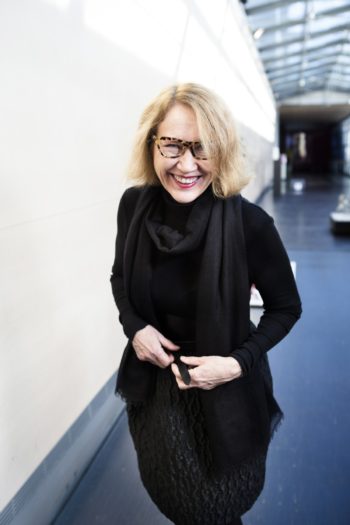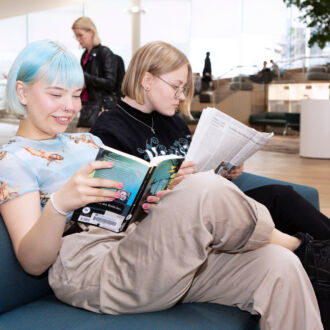A dynamic new generation of Finnish talent is attracting the attention of top fashion houses, the international press and scouts. Many of the rising stars have one thing in common – they have all been influenced by the pioneering work of Aalto professor Pirjo Hirvonen.
When Vogue Italia’s head of talent Sara Maino attended Pre Helsinki fashion week, the seasoned senior fashion editor and scout told Finnish daily Helsingin Sanomat that she was “amazed.”
In addition to the bright new talent, what astonished Maino was the exceptional quality of the fashion design programme at Aalto University School of Arts, Design and Architecture. In the past five years, graduating Aalto students have been snapped up by leading fashion houses ranging from Lanvin and Maison Margiela to Marimekko and Balenciaga, have won prestigious industry awards, and garnered attention in magazines ranging from W and Wallpaper to Vogue Paris.
Yet ten years ago Finnish fashion – with few exceptions – was not a headline-grabbing story in the international design press. What has happened?
“It originated from us,” answers Aalto professor of fashion design Pirjo Hirvonen. “We’ve developed a bold new culture in which we’re constantly renewing and developing the way we think and operate,” says Hirvonen, who was the head of Aalto’s design department from 2008 to 2015 and led the fashion and textile design programme from 2003 to 2008.
In addition to a strong network of alumni who hold key industry positions around the world and work closely with the school, there’s a strong learning-by-doing focus that sets Aalto apart from other high-ranking schools in the field such as New York’s Parsons and London’s Central Saint Martins.
“Our students design and make their own materials whether it’s the printed fabric for a collection or something else,” says Hirvonen. “Students know that if something isn’t available, they can make it. This model is worth gold: not just for this industry, but also as a way to solve problems in any field.”
Necessity is the mother of invention
Hirvonen’s vision was born largely out of her own experiences as a young designer. After graduating from the University of Art and Design (a predecessor to Aalto University), Hirvonen worked as an in-house women’s-wear designer in the 1980s and ’90s.
“At the time we were trained to create clothing for the Finnish clothing industry,” she says. With globalisation, that domestic textile industry has all but disappeared. Yet Hirvonen says that change was actually a blessing in disguise.
“It has forced all of us to think in new ways and understand that this is an international playing field – what’s good in Finland is simply not enough,” says Hirvonen.
As a young creative with many ideas for the international market, Hirvonen was told that her ideas were great, but wouldn’t satisfy domestic customers. “That response was terribly narrowing and crushing,” she says. But it filled her with resolve to turn that kind of thinking around.
“My core goal when I started with the fashion programme was that the mindset and way of teaching needed to be renewed. Creativity and vision without borders must be encouraged,” she says.
Learning how to sell

“Our students design and make their own materials whether it’s the printed fabric for a collection or something else,” says Pirjo Hirvonen of Aalto University. Photo: Mirva Kakko / Otavamedia
But good ideas are not enough. A strong business understanding of the global marketplace is crucial. To that end, Hirvonen has been responsible for instituting business management courses as part of the fashion programme, and she has taken on significant EU projects with other design schools, initiated multidisciplinary studies within the design department, and paved the way for a new sustainability Masters programme.
“We have many visiting instructors who work internationally in the field – all of our work needs to be strategic and operative,” says Hirvonen. “And it’s important to remember that not only the students are the talent – the teaching staff are, too. Talented teachers who understand this industry are essential.”
The programme’s rigorous selection process features one week onsite, during which applicants tackle a range of assignments.
“It’s a skill to know how to read the right signals – a student may be tired or nervous – but it’s important to see the overall picture,” says Hirvonen. “This field demands an authentic and passionate attitude, drive, and talent – without those it’s impossible to succeed,” she says.
Daring to be original
Finnish fashion is often characterised in broad strokes as bold yet sensible, minimalist, sustainable, and environmentally and socially aware.
Hirvonen says that while some of those descriptions hold true, she sees an underlying theme of courage: “Finnish fashion is characterised by daring to be original and following one’s own vision.”
“This young generation has had it very easy way compared to previous generations,” says Hirvonen, “yet they have seen the dangers of consumerism and are very ecologically and politically aware and think about all of the big questions. This shows in their designs, which are not throwaway clothes but long-term creations not tied to fleeting trends.”
When asked to offer up the names of the next set of future stars, Hirvonen is characteristically mum: “I never favour any one of my students over another. They’re like sweet buns baking in an oven: there’s always exciting new talent rising.”
By Katja Pantzar, April 2016



